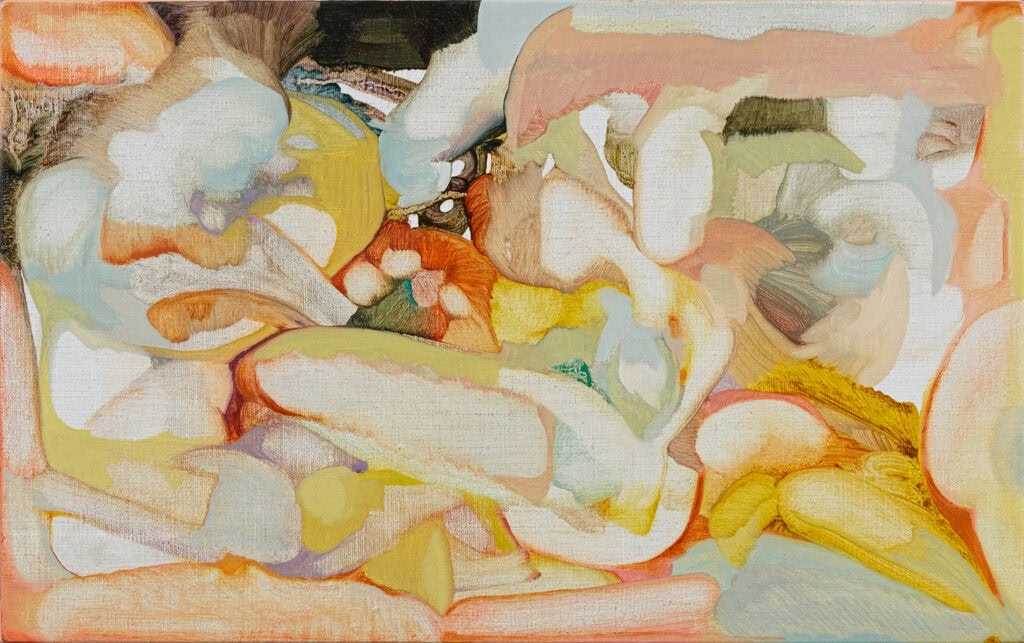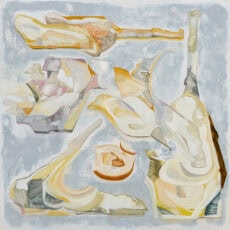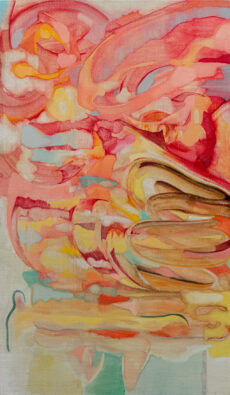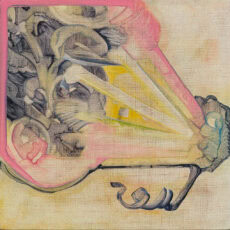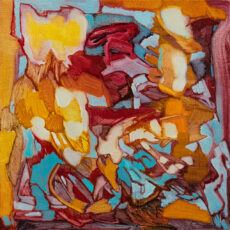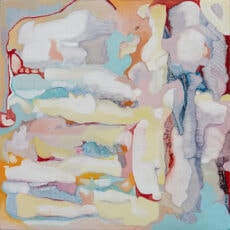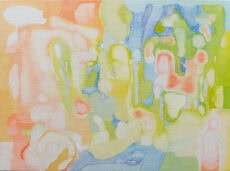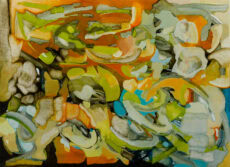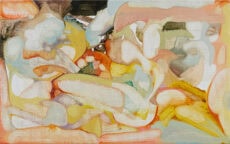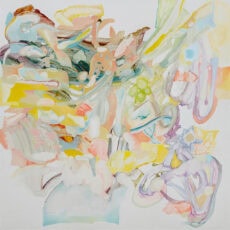Navigating Life’s Canvas: A Philosophical Exploration of Hui-Hsuan Hsu’s Perambulations in Art
By Peini Beatrice HSIEH
As Hui-Hsuan Hsu transitions from her thirties into her forties, her artistic focus has evolved from video art and photography to painting. Previously, her work was characterized by the perspective of a detached observer, capturing her surroundings through the long lens of a camera. Now, she is fully immersed in her environment, allowing herself to be moved and shaped by every ebb and flow. This nuanced shift in her artistic practice invites thoughtful exploration.
Hui-Hsuan Hsu asserts that while her photography, video art, and paintings all engage with abstract concepts through the visual and tactile layering of various media, each medium remains fundamentally distinct. She explains that the creation of images in photography and video is governed by technical controls, with preset parameters guiding the process toward anticipated outcomes. In contrast, painting involves a continuous internal struggle, immersing the artist in a state of conflict from conception to the final brushstroke.
Hsu describes her creative process as a response to explorations of memory and inner life, imbued with elements of longing, ambiguity, and a sense of distance, where she “encrypts her insecurities with the utmost subtlety.” Consequently, interpreting her work through the lens of her life philosophy becomes a possible perspective.
Henri Bergson (1859-1941) is renowned for his philosophical stance that privileges intuition and imagery over abstract concepts. In his view, describing the world or representing reality is best achieved through imagery and metaphor, as abstract concepts often bias and arbitrarily limit our understanding, failing to capture the full spectrum of reality. Bergson compared the creation of concepts through analysis to constructing a network from cumulative abstractions, like photographs taken from different angles—seemingly logical, yet lacking emotional resonance. While the rational evolution of collective thought can reinforce repetitive intellectual practices, it cannot substitute for the breakthroughs that arise from creative imaginings and intuitive speculation. This philosophical insight may offer insights to why Hui-Hsuan Hsu has temporarily distanced herself from image-based art.
The world is composed of both space and time, each possessing distinct characteristics: space is marked by extensivity, while time embodies duration. Since the invention of clocks, humans have misunderstood time as a continuum, like the movement of clock hands or the progression of numbers. This perspective fails to recognize that time is a carrier of qualitative change. Bergson challenged this view, asserting that although time can be scientifically measured through spatial averages, our perception of time and space is fluid, capable of changing at any moment without inherent consistency or regularity. Hence, the pursuit of qualitative diversity is more authentically human than the pursuit of mere quantitative variety.
The crux of the problem lies in the habitual misconception of the relationship between time and space, where measurable changes lead to the belief that mastering scientific time through units of progression equates to dominion over life itself. This perspective overlooks and denies the fact that the true human experience of time rooted in lived time. Only by acknowledging the limitations of concepts and embracing the absolute power of intuition can one grasp how distant places can feel immediate, how a mustard seed might contain a mountain, or why time may fly like an arrow, yet a single day can stretch as long as a year.
Hsu’s persistence in painting reveals her intent to capture the ever-changing essence of time. She understands that the purity of time is not achieved through objective, evenly divided increments, but through a continuous, participatory, and subjective layering that yields profound and multifaceted connotations. Only by relentlessly questioning the circumstances of life and exploring the inner self can one truly grasp the infinite variations in life’s unfolding.
While the durée (duration) of organic life is finite and cannot be extended, yet it is heterogeneous, never exactly the same. Bergson’s concept of durée is neither steadfast nor static, but exists in perpetual motion and flux. It can only be truly understood through direct experience and personal intuition. In other words, one must allow free will to engage with objects and events, unfolding autonomously and unpredictably, to open up alternative spaces for causality and create infinite possibilities for new outcomes.
Hui-Hsuan Hsu seeks to create shared spaces for collective memories. Without the capacity to remember, learning is impossible; practice and repetition serve to reinforce memory. While memory has the power to transform time into vitality, her work also reminds us of the essential role that forgetting plays in survival. Selective forgetting, at the right moment, allows people to reorient themselves, enhancing adaptability and freeing them from the past to focus on the future. This benefits both individual and collective survival.
Reality is far from static; it is entirely composed of change. In this light, each of Hsu’s diverse paintings can be seen as Post-It notes of varying shapes and colors. They capture memorable moments in the present, marking nodes at each turning point, and enabling the review, reordering, and reassembling of memories at any time to construct a narrative that bridges the past, present, and future.
A disciplined painter, Hui-Hsuan Hsu approaches her work with the same rigor and dedication of a writer who labors tirelessly at a desk. The titles of her works each read like a line of modern poetry, and when combined, they can collectively form a series of prose poems. This method evokes the creative process of Nobel laureate Olga Tokarczuk (1962-), who systematically fragments wholes, disrupting linear thought through vignettes, and employing multi-linear narratives to challenge habitual reading patterns. Tokarczuk meticulously weaves a magnificent tapestry, constructing constellations to guide the stargazing masses, who project their imagination onto the intricate starry expanse. Coincidentally, Taurus-born Hsu operates in a similar manner, as evidenced by her previous solo exhibition titled “Aldebaran in the Chamber of Secrets.”
Curator Tuan Tsun-Chen (1977-) believes that the Chamber of Secrets symbolizes the artist’s inner sanctuary within her home. He suggests that one must follow the clues Hsu provides and pinpoint the relevant coordinates to unlock the key to its connotations. I would posit instead that Hsu creates poetic dwellings through her immersive artistic interactions, offering a comprehensive strategy for anyone seeking to escape from their own chambers of secrets. As revealed in the title of her current exhibition, “You Found Me While I Was Looking for You,” the distinction between the characters for “found” (找) and “me” (我) hinges on the critical first stroke, which is indeed a stroke of creation.
Building on the foundation of cosmic ontology, Bergson believed that the life impulse is essential for bridging intuition, instinct, and duration. He considered the process of direct experience and intuition to be more critical for understanding reality than abstract rationalism and science. Only by sensing change can one gain spiritual energy. Under the catalytic intuition that sustains human life, only a continuous ‘creative impulse’ can maintain the constant flow of life force. Gilles Deleuze (1925-1995) advised affirming individual differences while rejecting collective repetition. In a schizophrenic world, breaking free from the constraints of evolution does not mean conforming; the vitality of life in perpetuity can only be assured by allowing diversity to flourish.
A favorite scorer of the late Greek director Theo Angelopoulos (1935-2012), master composer Eleni Karaindrou (1941-) once remarked that she felt like a painter, meticulously blending and selecting the base color for her works from countless shades. She created cinematic moments through her delicate tones, drawing inspiration from everyday experiences. Angelopoulos’s cinematography was meticulous about objectively presenting a narrative for the viewer to contemplate, while Karaindrou’s music skillfully evoked deep-seated emotions. In my view, Hsu’s work shares this musicality and artistry.
Hsu’s expert camerawork is still evident when viewing her paintings and static works. She is both the subject of the image and the one behind the lens, facilitating the projection of multiple texts. It is as though she transforms into the stork that wanders solemnly across melancholic plains, clearing the remnants of life’s vicissitudes and reverently gathering particles of time as treasures to present to us. We, who have come to appreciate the beauty of a world in a grain of sand, then joyfully dance to the rhythm of her minuet and divertimento.
Though meticulously ordered in both her demeanor and workspace, it is evident that Hsu is a perceptive and sensitive being. When the artist ignites her innate irrationality, an incomparable surge of life energy is released, allowing her internal life philosophy to unfold and settle into a unique pattern within her work. Emotions arise spontaneously and remain passionately committed. She explains that the moment to stop painting comes naturally, like flowing clouds and running water, pausing effortlessly where it should.
A sufficient reserve of vital life force is necessary to master the visible beauty and wonders perceivable by the five senses. Once fully mastered, one can leisurely and blissfully lose oneself. The image becomes harmonious and complete, rich in detail and suffused with a heightened sense of beauty.
Regardless of the size of the canvas, the artist’s emotions and disposition ultimately capture glimmering glimpses of her life as she navigates her daily affairs. These feather-light images magically preserve the essence of each season—spring’s vitality, summer’s heat, autumn’s light, and winter’s scenery.
When displayed in a row, forming a meandering horizon line in the artist’s living quarters and bathed in light, her works evoke a distinct emotion. The viewer realizes that this is not a methodical exercise in painting technique, nor a planned stroll, but rather an impromptu yet persistent perambulation.
During the Wei and Jin Dynasties, the literati engaged in the consumption of the psychoactive Five Minerals Powder as part of their Taoist practices. This ritualistic intake was followed by a need to dissipate the resultant heat energy, accomplished through the consumption of cold foods and the performance of meditative ambulations, a practice that later became known as “walking and dispersing.” This evolved into a sophisticated cultural trend among scholars, who would embark on these walks together, reflecting on the ephemeral beauty of their surroundings and composing poetry with a refined and elevated sensibility. Even when they parted ways, they believed that “Our Dreams Rhyme with Each Other. “
During the Taika Reform, the Japanese fully assimilated Tang culture and embraced the practice of walking and dispersing as a means to glean the profound essence of life. Walter Benjamin (1892-1940), building upon Charles Baudelaire’s (1821-1867) portrayal of the modern artist as a flâneur, further solidified the archetype of the urban wanderer. Hui-Hsuan Hsu includes herself in this lineage. However, unlike Marcel Proust’s (1871-1922)elusive female passantes, Hsu is a deliberate traveler.
Innately rational and perceptive, Hsu demands that her canvases adhere to precise measurements, yet she possesses a rare ability to discern the subtleties that others might overlook on life’s intricate journey. She masterfully translates these nuanced observations into her work, rendering them fully on her canvases.
Whether capturing silhouettes in Soapfilm (2016) or Pipilotti Rist’s (1962-)reading notes, each of Hsu’s creations charts the trajectory of her mind, nurturing a korfulamu*on the verge of blossoming.
The aspiration to freeze time’s fleeting moments may seem quixotic, yet even if it ends in futility, the beauty left in its wake is undeniable. What could be more romantic than persisting in the face of the impossible?
Exhibition Title: I Was Looking for You, Then You Found Me – HuiHsuan Hsu Solo Exhibition
Exhibition Period: Sep. 7, 2024 (Sat) – Oct. 19, 2024 (Sat)
Opening Tea and Artist Talk | Sep. 28, 2024 (Sat) at 15:00
Moderator | Pei-Ni Hsieh
Opening Hours: Tuesday to Saturday, 13:00-19:00

